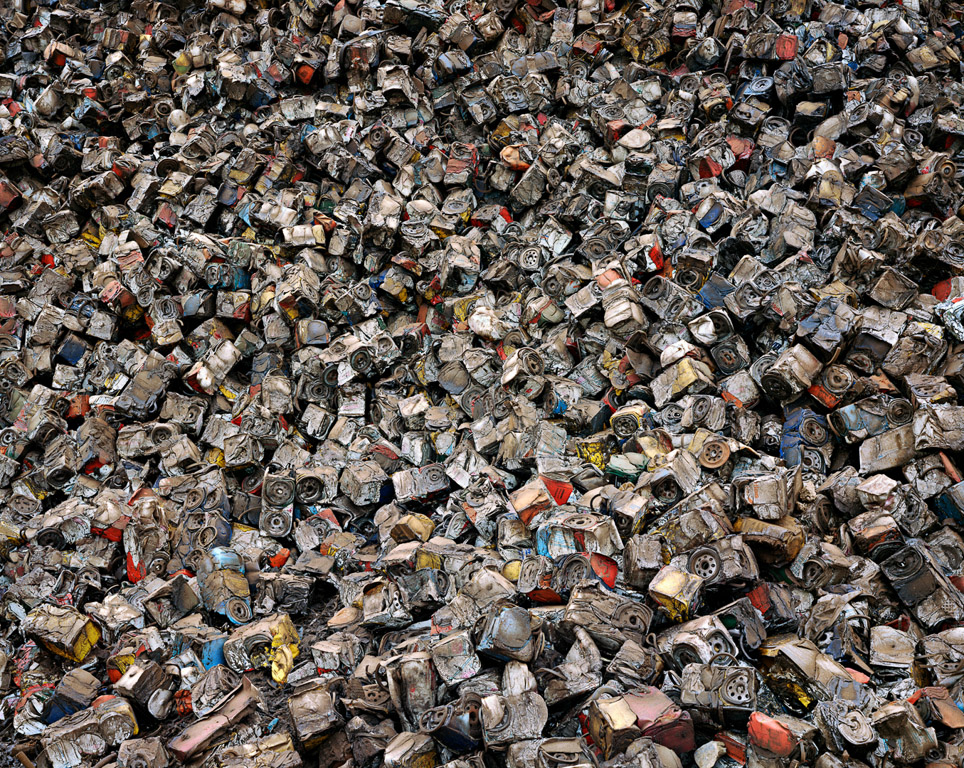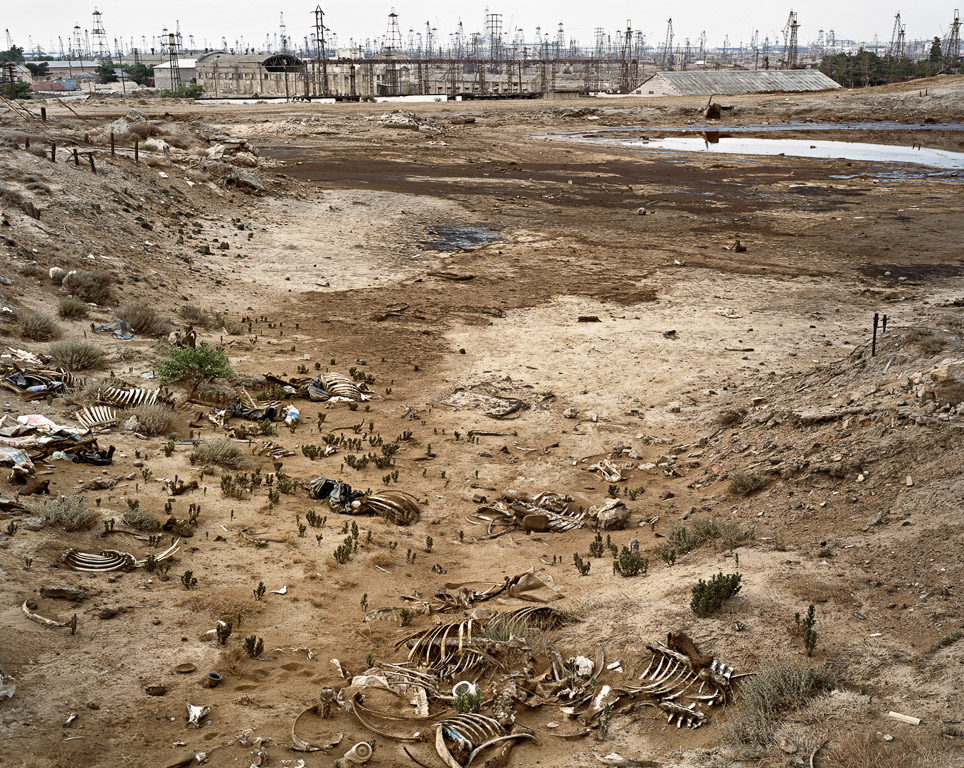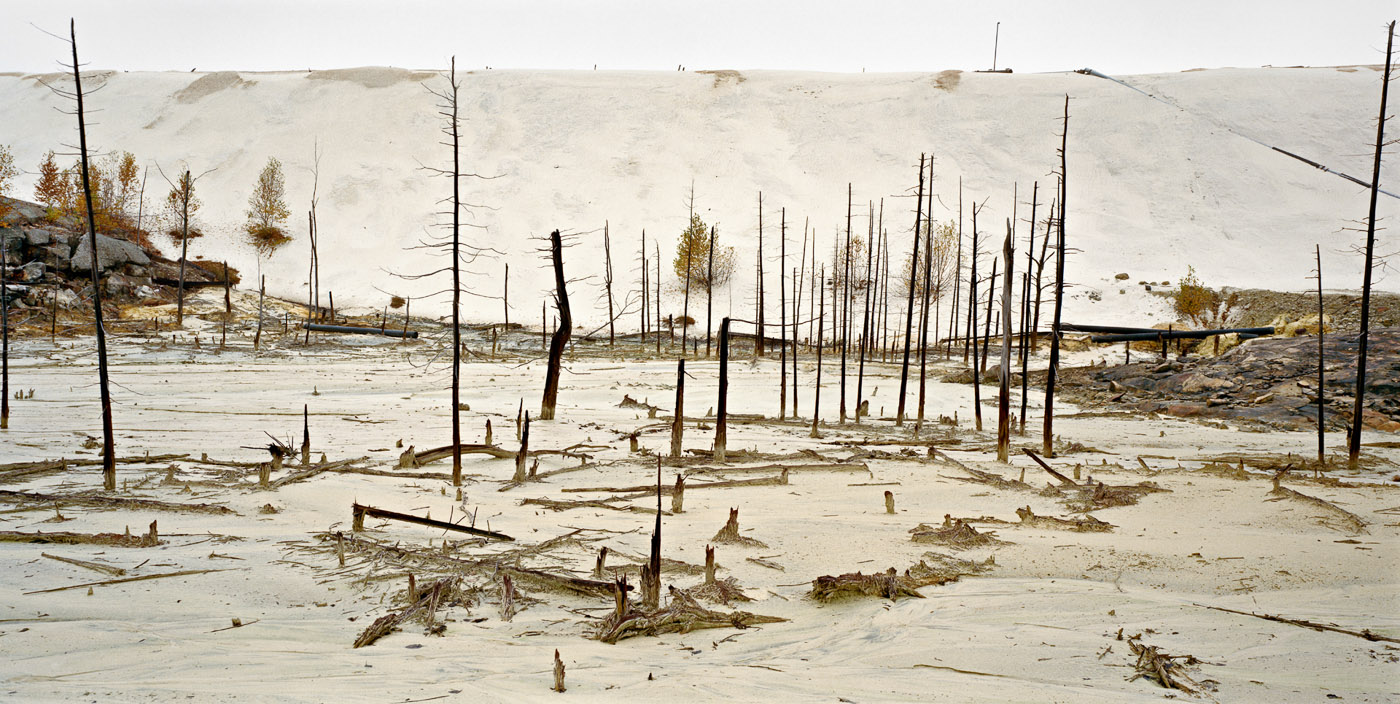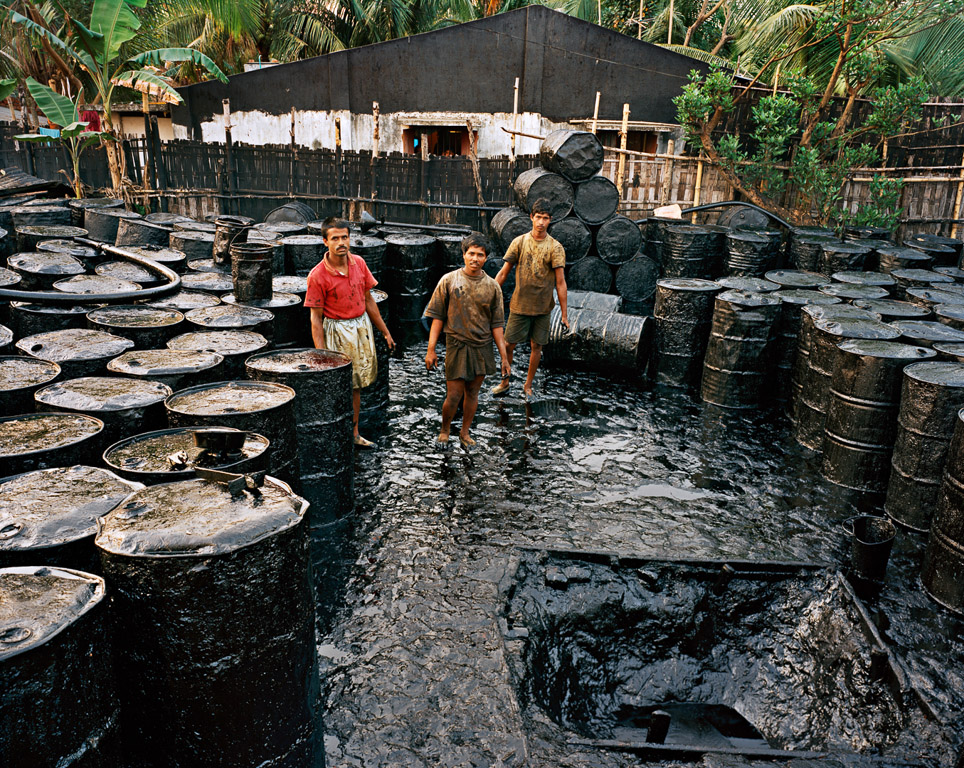By Nick Glass, CNN, May 18, 2018
 |
| Densified oil filters, Hamilton, Ontario, 1997. Photo: Edward Burtynsky. |
Edward Burtynsky likes to think big. It's always been his natural inclination. Every time the Canadian photographer frames an image, he imagines it big. The bigger the print the better -- anything up to 9 feet by 18 feet -- which makes complete sense, given the size of his subject matter.
For some 35 years, Burtynsky has been photographing humankind's industrial intervention in natural landscapes. His panoramas have expanded with technology. Since 2003, he has used helicopters and, since 2012, a bespoke drone. His images help us look down on our planet in a new and detailed way
We all know that humans are scarring the landscape. But Burtynsky provides the visual evidence on a breathtaking scale: great wounds slashed into the earth -- from coal and copper mines, oil refineries, salt pans -- and all the wasteland, spills and debris that result from them.
As with NASA's photographs from space, there is an unquestionable beauty to Burtynsky images. He brings a painterly eye to the landscape -- and that's the paradox. "The technical revolution has turned us into a virus consuming all living organisms, diminishing biodiversity," he says.
 |
| SOCAR oil field, Baku, Azerbaijan. Photo: Edward Burtynsky |
But as Burtynsky is well aware, he is recording it beautifully, making it as "visually compelling and as transcendent" as he can. "It's an immersive thing" for the viewer. In Burtynsky's vision, the apocalypse has its sublime moments.
I meet up with Burtynsky during a fleeting visit to London. (He has been named "Master of Photography" for this week's Photo London fair, where he's showing work and has given a talk.) He's evidently a busy man, and his lifestyle more than a little nomadic. He has just opened an exhibition of his work outside Frankfurt, and, before that, was on an underwater shoot in Indonesia.
Burtynsky's prints are large, usually 60 inches by 80 inches. You often need to read the labels to know precisely what you are looking at. The photographs on show in London range from copper mining in British Columbia (the viewer peers down into a great pit beside a sinuous road of loaded trucks climbing and descending) to oil pirating in the Niger Delta (a scorched earth of oil slicks, languid muddy waters and sparse vegetation) and a gleaming Italian marble quarry (an astonishing vertical wall of Carrara marble, marked out in great blocks and ready for extraction).
 |
| Los Angels, U.S. 2003. Photo: Edward Burtynsky. |
Throughout our interview, Burtynsky refers to himself as "an artist." His work, he tells me, has been influenced by the Abstract Expressionists. In previous interviews, he's made reference to Jackson Pollock and Paul Klee, and you can see this in the shapes and subdued earthy palettes of his photographs. "I am thinking of Pollock in the intensity and vibrancy of the surface," he explains.
 |
| Uranium trailing. Elliot Lake, Ontario, 1995. Photo: Edward Burtynsky. |
In Burtynsky's photographs, we look down on swirls, spirals and loops. The landscapes sometimes look quilted, man-made rectangles of muddied color and watery rainbow oil slicks. In depleting our natural resources, we humans can't help ourselves. We must make marks and patterns. Looking at them, I find myself longing for signs of life, and in a few photos you can just make out the occasional human being -- tiny figures in hard hats among sawmills, or villagers paddling boats in the oil swamp of the Niger Delta.
Burtynsky has entitled his latest body of work "Anthropocene," the term some scientists use to define our current age, as humanity has become the dominant influence on the planet's climate and environment. He believes this era began in the 19th century with the widespread use of the internal combustion engine. Others think it began later, after 1945 and nuclear testing.
Regardless, Burtynsky claims to be non-judgmental, saying that his work is "revelatory, not accusatory." The landscape is simply "the consequence of what we are." He likes to hope that his images -- his "compendium of that rash spread across the planet," as he puts it -- has had some impact, not least on the next generation who are "less engaged in materiality."
This leads us to the bluntest of questions: What's the future of our planet?
"I like to remain optimistic that technology will save the day," Burtynsky replies, though his tone suggests otherwise. He expresses surprise at "how slow we are to react, and how impossible it seems to tackle the problem on the scale it needs to be tackled." And when Donald Trump was elected Burtynsky didn't sleep for a week. "After 35 years looking at the wastelands of our cities, of our lives, we're running out of time," he says.
Yet Burtynsky doesn't speak in an impassioned or alarmist way. Easygoing by nature, he's said it all before and will do so again. It's simply what he's observed -- and it makes him anxious.
 |
| Shipbreaking, Chittagong, Bangladesh, 2001. Photo: Edward Burtynsky. |
A return to nature
As a young photographer, Burtynsky was first interested in "pristine landscapes" and his own yearning for the past. He cites two great 20th-century American photographers as early influences: Ansel Adams, with his majestic images of the American West, and Eliot Porter, for his intimate portraits of nature. But Burtynsky quickly realized that "the altered landscape was truer to my time as an artist."
 |
| Spain, 2010. Photo: Edward Burtynsky. |
It all began close to home in 1983, just "me and my car and my camera," photographing railway lines cutting through the Rocky Mountains, and the coalmines of Western Canada. Then he went a little further afield to an open-pit copper mine near Salt Lake City. Burtynsky sold his first series of landscape photos to a museum for $200 soon afterward.
He admits that he never expected to make a living doing this type of photography, and, at the beginning, he subsidized his work by setting up a commercial photo lab in Toronto. Now he sells his large-format photographs, in editions of three, at $100,000 each. He also plans elaborate photographic shoots that can cost him just as much.
 |
| Kennecott copper mine, Bingham Valley, Utah, 1983. Photo: Edward Burtynsky. |
Burtynsky acknowledges that he isn't alone in his niche, though his approach is perhaps the most global. Other North American photographers have absorbed themselves in the Earth's scarred landscape, and he names three in particular: Emmet Gowin, David Maisel, and Richard Misrach. But their work is focused on America's landscape. Burtynsky, meanwhile, continues to travel widely with "that very useful tool, Google Earth" and a team comprised of -- among others -- a producer, a documentary filmmaker, and a drone operator.
Access is often the biggest challenge. "They don't want you there!" I interject, and he agrees. Nine months ago, he was in the northernmost city in the world, Norilsk in northern Russia, where there are huge open mines for nickel, copper, and palladium. "That was tough," says Burtynsky, who obtained a Russian visa for cultural activities. (Had he tried to enter as a journalist, it is unlikely that he would have been allowed in.)
In 2005, Burtynsky published a book about China called "China" ("I'm not very poetic in my titles," he admits cheerfully). Now, for his next book, he's switched his attention to Africa. At 63, he's quietly ticking off the countries he's photographed, which now includes Nigeria (whose capital, Lagos, he refers to as "the hyper-crucible of globalism"), Kenya (where he captured a huge pyre of burning elephant ivory) and Ghana (where he photographed an engine recycling plant from above).
 |
| Plastic toy parts. Guiyu Guangdong province, China, 2004. Photo: Edward Burtynsky. |
Since then, the photographer has allowed himself some brief respite. He's recently returned to "the pristine" by photographing ancient forests in Vancouver and coral reef in Indonesia's Komodo National Park in Indonesia, where he recently took a team of ten divers. The result -- yet to be published -- will be a 200-square-footprint showing a wall of coral precisely the same size. The chosen image is a composite of 160 high-resolution shots stitched together digitally. "Amazing colors," reflects Burtynsky, "reds, oranges, purples."
Burtynsky has often made reference to Henri Cartier-Bresson's famous remark about "the decisive moment" of taking a great photo. Yet he reminds me that his own approach is rather different -- "contemplative and methodic." Burtynsky likes to take his time and wait for the right light, which he says is overcast but bright). Then, of course, he likes to make the final image as big as he can.
Burtynsky has often made reference to Henri Cartier-Bresson's famous remark about "the decisive moment" of taking a great photo. Yet he reminds me that his own approach is rather different -- "contemplative and methodic." Burtynsky likes to take his time and wait for the right light, which he says is overcast but bright). Then, of course, he likes to make the final image as big as he can.

No comments:
Post a Comment